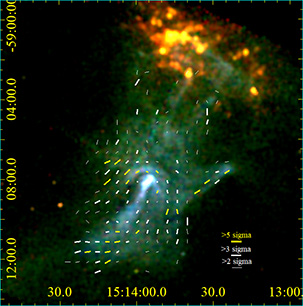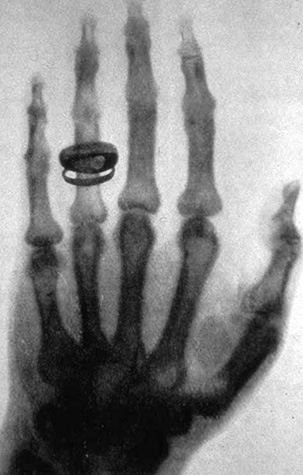X-raying the Magnetic Field Bones of the Cosmic Hand

Roger Romani
We welcome Roger W. Romani as a guest blogger. Roger is the first author of a paper that is the subject of our latest Chandra release. He has been a professor of Physics at Stanford University for 30-odd years and helped found KIPAC, its institute focusing on astrophysics and cosmology. He is interested in high energy astrophysics problems of all sorts and likes to bring observations from multiple wavebands together with modeling to explain astrophysical puzzles. However, he has a special fondness for the extreme physics conditions associated with pulsars and their environments. Today’s blog gives one such example.
Magnetic fields are the binding agent that turn interstellar atoms into gases. Between the stars the particle density is so low that, without these fields, individual atoms would fly along like buckshot, essentially never colliding. But since the atoms are often ionized – with a positive charge because negatively charged electrons have been stripped away – their interaction with embedded magnetic fields forces them to flow in concord, resulting in the fluid-like behavior that forms many of the nebulas that enthrall us in astronomical images.
It is surprisingly hard to image this magnetic scaffolding. A new capability for magnetic mapping was introduced with the launch of NASA’s Imaging X-ray Polarimetry Explorer (IXPE) in late 2021. This telescope is sensitive to 1-10 keV X-rays and, using an ingenious photo-electron tracking camera developed by our Italian colleagues, is able to sense the polarization, or orientation of the electric field in the electromagnetic wave, of the individual X-ray events. (An “eV” is an electron volt, a unit that represents how much energy an electron gains when it is accelerated by the potential of one volt. A “keV” is 1000 eV.) So together with its imaging, timing, and energy resolution capabilities, IXPE can, for the first time, extract (albeit imperfectly) all of the information carried by each X-ray photon. The result is a color movie of the target, which also shows how the local emission is polarized.
Some of the most interesting IXPE targets have been the so-called `Pulsar Wind Nebulae’ (PWNe), generated when rapidly spinning neutron stars accelerate electrons and positrons to energies of 10s of trillions of electron-volts (tens of TeV), higher than we can reach with particle accelerators like the Large Hadron Collider. These multi-TeV charged particles are guided, and further accelerated, by embedded electromagnetic fields in the region surrounding the pulsar. Thus, this particle wind, with its magnetic field binding agent, flows out to form complex clouds, glowing in synchrotron radiation. And since the particle motion is organized and guided by the magnetic field, that synchrotron glow is polarized. IXPE images of these PWNe thus reveal the magnetic field geometry that shapes their structures.

Chandra 3-color image of MSH 15-52 with IXPE vectors overlaid. (Credit: NASA/CXC/Stanford Univ./R. Romani et al. & NASA/MSFC)
My research group have been interested in PWN emission for many years and have used Chandra, NASA’s premier X-ray imager, to map a number of nebula around energetic pulsars. Interestingly, early-on when the new-born pulsar is still deep in its parent supernova remnant, or at late times after it has escaped to the relatively uniform interstellar medium, the pulsar wind is often uniform around the pulsar spin or velocity axis. In projection on the sky such structures have bilateral symmetry, that is, the two halves mirror each other. This makes them look (vaguely) like animals. This has led to many PWNe collecting animal monikers (‘The Mouse’, ‘The Dragonfly’, ‘The Rabbit’ – we are guilty of some of these…).
In between these early and late phases, the story is often more complex and the PWN interaction with the supernova shock wave leads to complicated morphologies. One of the prime examples is the PWN in the supernova remnant RCW 89 (also known as MSH 15-5(2)). Here the complex interactions form the PWN into the `Cosmic Hand’. Wanting to map the magnetic fields which structure this hand, the IXPE team took a long hard stare at MSH 15-5(2) and its central pulsar.

An early X-ray picture (radiograph) taken at a public lecture by Wilhelm Röntgen (1845–1923) of Albert von Kölliker's left hand. (via Wikipedia)
This has some interesting historical resonance. Shortly after Wilhelm Röntgen‘s discovery of X-rays on November 8, 1895, he created one of the most famous of all scientific images: an exposure of a colleague’s left hand, showing the bones with attendant rings. IXPE has thus followed Röntgen’s lead in imaging the magnetic field `bones’ of the cosmic hand. We also make a seasonal connection by presenting this skeletal image around Halloween.
Of course IXPE’s goal is to extract science from these data, as well as create a striking image. Celestial X-ray signals are faint, and as an explorer-class mission, IXPE’s aperture is modest, so the exposure needed to be long. At about 1.5 million seconds on-source, this took about a month of IXPE’s observing time. But when combined with the superior angular resolution of the Chandra image, IXPE’s polarization vectors nicely trace the underlying magnetic field structure.
In part the results are as expected: the field lies along the thumb, fingers and other linear structures. In other areas the field polarization maps the energetic acceleration zones, such as the arc in the hand’s palm that brackets the central pulsar accelerator. Parts of the field structure are not yet fully understood. For example, the high-energy (blue in the Chandra image) ridge of emission trending south of the pulsar in the hand’s wrist: this is often interpreted as a ‘jet’ and we see limited polarization indicating weak or scrambled fields near the pulsar, but high polarization indicating strong ordered fields near toward the jet’s end. Overall the field organization is very high, with regions approaching 70% polarization level, the maximum allowed by synchrotron theory. This has been seen by IXPE in other PWNe, too and is an important clue to the processes driving the electron and positron particle acceleration and radiation.
Much remains to be learned about these magnetic field structures. As Chandra continues to map out the shapes of synchrotron nebulae and as IXPE X-rays trace the magnetic field `bones’ of more PWNe, we expect this comparative anatomy to advance our understanding of these most powerful, and photogenic, cosmic particle accelerators.
- Log in to post comments
